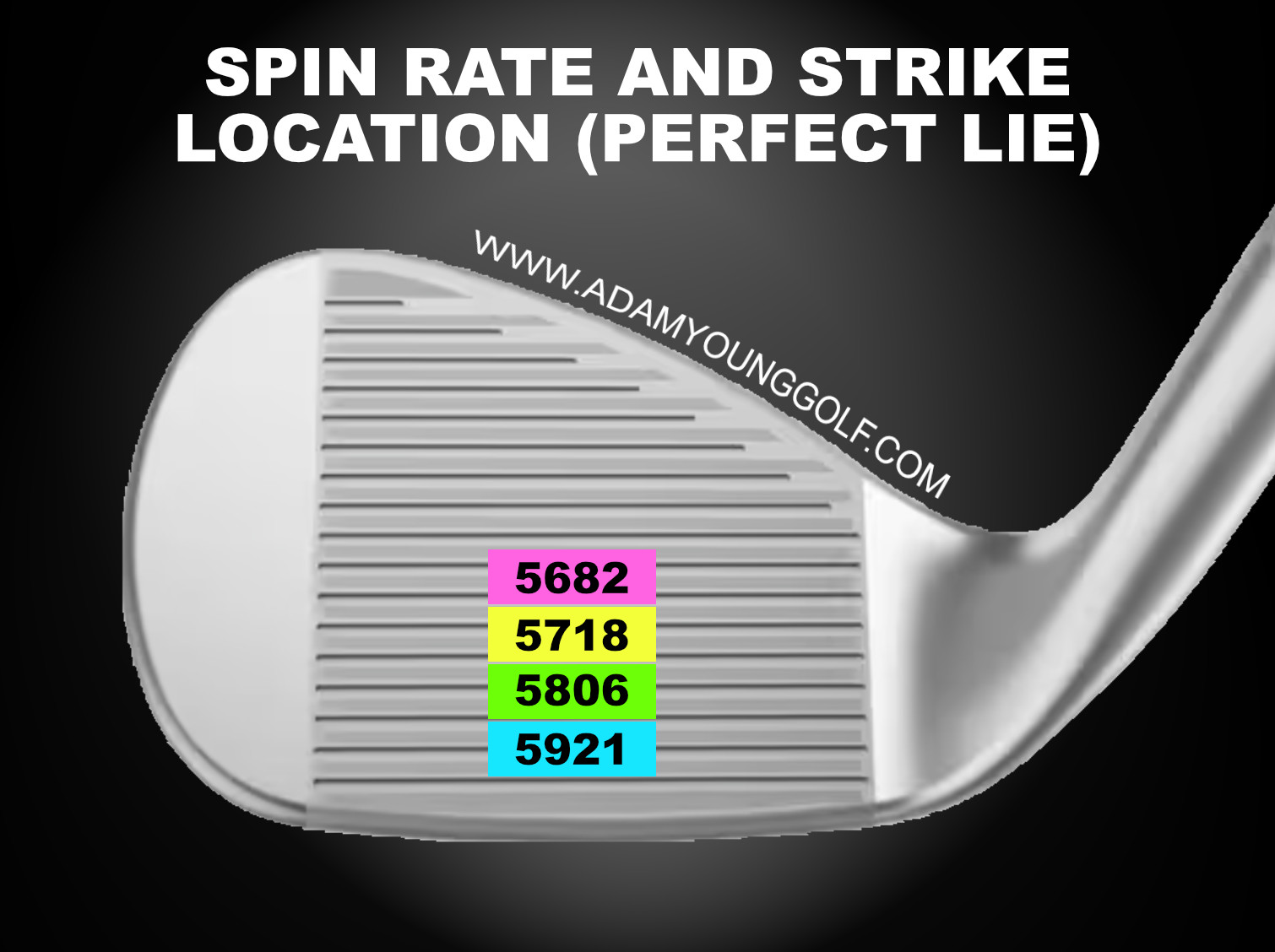
I hit 100 golf wedge shots with a launch monitor running.
Let’s see what I found out, below. The data is super interesting.
Before You Do
Make sure you get your copy of my FREE eBook – Golf hacks. It has simple tips to help you
- fix shanks and toe shots
- fix fat and thin shots
- help with your over-the-top/under-plane swing
- hit more greens through better strategy
and much more. Did I mention it’s FREE! Just enter your email below to get it sent to you – then continue reading this article
Lies, Damned Lies, and Statistics
For the test, I hit shots from 2 different lies indoors.
- Grass-simulated lie (Fiberbuilt bristles) which would simulate having a perfect lie with a big cushion beneath the ball
- Normal range mat – tight and firm – like a hardpan lie but a bit more spongy
Shots were
 40 yards
40 yards
 45 deg dynamic loft (yellow arrow)
45 deg dynamic loft (yellow arrow)
 8 deg attack angle (white line)
8 deg attack angle (white line)
 53 deg spin loft (pink shaded area)
53 deg spin loft (pink shaded area)
All had very tight standard deviations – showing consistency delivery.
Perfect Lie Spin Rates
This is a visual of the average spin rates for the different vertical face strikes for the GRASS lie.

We see relatively consistent spin rates. There is a drop-off as we go higher up the face (which will be explained later), but the difference between low and high on the face was just 239 RPM.
Any ideas yet as to why?
Tight Lie Spin Rates
This is a visual of the average spin rates for the different vertical face strikes for the TIGHT lie.

Wow – what a difference!
Overall, the spin rates are down for each segment.
We see the same trend – lower spin rates higher up the face, but the variability is greatly increased. The difference between high and low on the face is a whopping 1,322 RPM – over 5.5 times more than for the perfect lie.
And, for easier comparison, here they are side by side.

And here’s a charted visual of the data.
We see the trend lines go down, showing spin rate decreasing as vertical strike increases. However, the line is much steeper for the tight lie.
Why does spin rate get lower as the strike goes up the face?
In these examples..
- It’s NOT gear effect – irons have little to no gear effect
- It’s NOT debris – no mud/water on the mats
The answer is…..
Dynamic Spin-Loft
While a launch monitor often shows the data (attack angle, loft, spin loft) WITHOUT the club-ball collision, this collision matters.
You see, as the clubhead is in contact with the ball, it gets deflected down by the force of the ball (yellow).
Dave Tutelman calls this “Newton’s Divot”- it can explain how someone can have a divot after the ball even with a slightly positive attack angle. Imagine a club coming in with a level attack angle, and then the ball forces the clubhead down into the ground post-impact.
When we strike low on the face, the club interacts with the mud late (pink star, below). In many cases, the ball may be completely gone before the club touches the mud.
It’s free to be deflected down more through impact – increasing spin loft, thus (in this example) spin rate.
However, when we hit higher on the face, we’re essentially interacting with the turf further back (earlier).
This gives more time for the club attack angle to deflect “less down”, changing DYNAMIC SPIN LOFT (through the ball). This is why higher face-strike locations correlated with lower spin rates.
- more deflection through impact
- thus lower dynamic spin loft
- thus lower spin
But why such a difference between lies?
Different Lies
On the;
- Grass lie – interaction with the ground is always farther forwards (later) + softer. Meaning less time to deflect the attack angle, and by a lesser amount
- Tight lie – interaction with the turf is much earlier and more violent, meaning bigger dynamic spin loft changes
We can see this visualized here (below).
Lie with grass cushion beneath it with predicted attack angle (green).
vs deflected (yellow).
By the time the club bounces up, the ball has already gone. Or, we could say, the club is free to continue on its downward attack angle through the ball.
Now (below) we see the exact same swing (striking the same groove on the face vertically) but from a tight lie.
We see the actual club trajectory/attack angle (yellow) changing earlier. This results in a greater change of spin loft through impact, thus higher spin-rate changes in the ball.
This is also why you see launch angle increase more rapidly for the tight lie.
Please note, the crossover in lines before the -15mm mark is likely due to less data in this range.
The increase in upward deflection of the clubhead “bouncing” off the turf created a more variable and higher launch angle.
Distance Problems
Not only was
- Spin lower
- launch higher
For the tight lie, but it also had more variability to those factors.
This resulted in more distance per mph of club speed, and more variability in distance (or less distance control). The below chart adjusted for club speed, then plotted the resulting distances if you were to hold club speed constant at 44mph.
We see the perfect lie trend was 39 to 44 yards.
The tight lie trend was 38 to 46.5 yards.
Overall Consistency
I then grouped the shots into either
- -20 to -10mm (good to pro-thin range)
- -10 to 0mm (good to pro-fat range)
For Grass Shots:
-20 to -10: Standard deviation is 1.30 yards
-10 to 0: Standard deviation is 1.45 yards
For Tight Firm Lie Shots:
-20 to –10: Standard deviation is 2.03 yards
-10 to 0: Standard deviation is 2.16 yards
This shows that the tight firm lie shots have higher variability in distance within each group compared to the grass shots
What This Means For You???
More research needs to be done from varying lies, with real grass too, and at different spin lofts.
But this study shows
 The “bounce up” effect that can occur when the club interacts with the ground too early
The “bounce up” effect that can occur when the club interacts with the ground too early
 Hard-pan, range mats or similar lies will give higher launch and lower spin, often resulting in more distance and distance variability
Hard-pan, range mats or similar lies will give higher launch and lower spin, often resulting in more distance and distance variability
 Even similar launch-monitor-reported spin-lofts can produce very different launch and spin characteristics, due to what is happening THROUGH impact
Even similar launch-monitor-reported spin-lofts can produce very different launch and spin characteristics, due to what is happening THROUGH impact
 It may be harder to control distance from tight, hardpan lies – even if contact is cleaner (no grass)
It may be harder to control distance from tight, hardpan lies – even if contact is cleaner (no grass)
 Bounce may not always be your friend – in some cases it may be the thing that creates less consistent spin/launch/distance control
Bounce may not always be your friend – in some cases it may be the thing that creates less consistent spin/launch/distance control
 It explains those low-nipped wedge shots that spin more when you catch the bottom groove
It explains those low-nipped wedge shots that spin more when you catch the bottom groove
 Striking more towards the bottom of the club (as long as not bladed) may give more consistent distances from varying lies
Striking more towards the bottom of the club (as long as not bladed) may give more consistent distances from varying lies
I’ll also mention that we may be able to use this bounce-up effect to create high-launching, high-spinning shots. But that’s for another article – so stay tuned.
What else did YOU get from this data? Maybe a headache?
Next Steps
If you made it this far, you obviously love nerding out on deep golf information….
And there’s nothing deeper and more nerdy than my Next Level Golf program. I promise it will get you thinking of golf in ways you’ve never thought before.
A library of over 150 hours on every part of the game imaginable – from
- wedges,
- impact physics,
- strategy,
- match-ups and technical info,
- practice design/planning,
- motor learning drills etc.
Check it out by clicking the image link below. What on earth are you waiting for – there’s literally nothing else like it!
The post Wedge Study – Tight vs Perfect Lies appeared first on Adam Young Golf.
